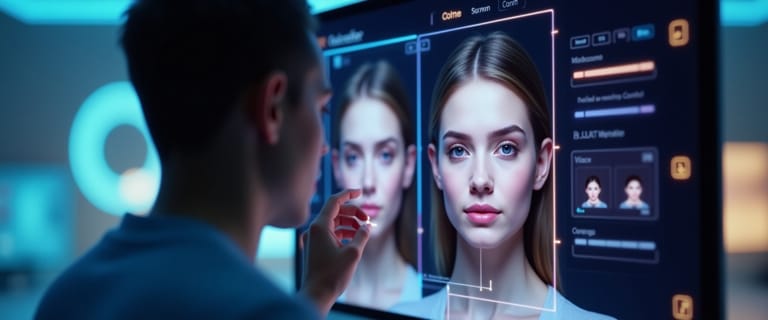The eyes are the heart of any portrait. They draw the viewer in, convey emotion, and tell a story. When the eyes in a photo aren't quite right—whether it's a slightly averted gaze, a half-closed lid, or a lack of sparkle—the entire image can fall flat.
AI photo editing has made fixing these issues easier than ever. But not all "AI eye editors" are created equal. Many offer basic, often unnatural-looking fixes. This guide breaks down the top 5 AI tools specifically for editing eyes, giving you an honest look at their strengths and weaknesses, and revealing which one provides the most control and the most professional results.
What to Look For in an AI Eye Editor
- Realism: Does the tool understand facial anatomy, or does it just stretch pixels?
- Control: Can you make subtle, granular adjustments, or are you limited to a single "enhance" slider?
- Completeness: Does it only handle one aspect (like size), or can you adjust gaze, openness, and expression together?
1. Expression Editor AI: The Specialist's Choice
Expression Editor AI is a specialized platform built for professional-grade facial editing. Its eye-editing capabilities are the most comprehensive and realistic on the market.
Strengths:
- 3D-Aware Editing: Its core strength. The AI understands the 3D structure of the human face, so adjustments are anatomically correct, preserving natural shape and lighting.
- Precision Gaze Control: A dedicated joystick for Pupil Direction (
pupilX,pupilY) allows for minute, precise changes to where the subject is looking. This is a feature most competitors lack and is essential for perfect eye contact. - Natural Eye Widening: The 'Blink' slider doesn't just stretch the eye. It naturally adjusts the openness of the eyelids, making eyes appear bigger and more alert without the fake "anime" look.
- Complete Expression Control: The 'Eyebrow' slider allows you to raise or lower the brows to match the new eye expression, creating a cohesive and believable result.
- Generous Trial Credits: You can test all advanced features with the free credits you receive when you sign up.
Weaknesses:
- As a web-based platform, it requires an internet connection.
2. Luminar Neo: The General Photo Enhancer
Luminar Neo is a powerful, AI-driven photo editor loved by many photographers for its landscape and general portrait tools.
Strengths:
- Good "Iris Flare" and "Eye Whitening": It does a good job of making eyes look brighter and clearer.
- Simple User Interface: Very easy for beginners to pick up and use for overall photo enhancement.
Weaknesses:
- Very Limited Gaze Control: It lacks any tool for precisely redirecting the subject's gaze.
- Basic "Eye Enlarger": The tool for making eyes bigger can easily look unnatural if pushed too far, as it's based on 2D stretching.
- No Eyebrow Adjustment: You cannot adjust the eyebrows in concert with the eyes, which can lead to an emotionally disconnected expression.
3. Fotor: The Quick Online Editor
Fotor is a popular, browser-based photo editor with a wide range of features, including some AI touch-up tools.
Strengths:
- Accessible and Easy: Very simple to use for quick edits, including red-eye removal and a basic "eye enlarger."
Weaknesses:
- Lacks Subtlety: The eye-editing tools are not very sophisticated. The "eye enlarger" is a simple slider that often produces noticeable distortion.
- No Gaze or Expression Control: You cannot adjust pupil direction or eyebrow position, limiting its use to very basic enhancements.
4. YouCam Perfect: The Mobile Selfie Editor
YouCam Perfect is a leading mobile app designed for perfecting selfies for social media.
Strengths:
- Fast and Convenient: Excellent for making quick edits on your phone.
- Feature-Rich for Selfies: Includes a huge array of filters, beautification tools, and effects.
Weaknesses:
- Built for "Beautification," Not Realism: The tools are designed to create a specific, idealized social media look, which often sacrifices naturalism. The eye-editing tools can easily look artificial.
- No Desktop Version: Limited to a mobile workflow.
5. Facetune: The Original "Touch-Up" App
Facetune is arguably the most famous mobile touch-up app, known for its powerful and sometimes controversial beautification features.
Strengths:
- Powerful Reshaping Tools: Its manual reshape tools offer more control than many other mobile apps.
Weaknesses:
- The "Facetune Look": The app is notorious for producing an overly edited, plasticky look. Achieving a subtle, natural result is very difficult.
- Manual and Tedious: While it offers control, it requires a lot of manual pinching and pulling, which can be time-consuming to get right.
Feature Comparison: Eye Editing Capabilities
| Feature | Expression Editor AI | Luminar Neo | Fotor | YouCam/Facetune |
|---|---|---|---|---|
| Realism | Excellent | Good | Fair | Poor |
| Precise Gaze Control | ✅ Yes | ❌ No | ❌ No | ❌ No |
| Natural Size Adjustment | ✅ Yes | ✅ Yes | ❌ No | ❌ No |
| Eyebrow Control | ✅ Yes | ❌ No | ❌ No | ❌ No |
| Trial Credits | ✅ Yes | ❌ No | ✅ Yes | ✅ Yes |
Conclusion: Why Specialization Matters
While many tools can "edit photos," perfecting the eyes in a portrait requires a specialized approach. General editors like Luminar and Fotor offer basic enhancements, and mobile apps like Facetune prioritize speed over realism.
For creators who demand control, subtlety, and believable results, Expression Editor AI stands in a class of its own. Its unique AI engine, combined with granular controls for gaze, openness, and brow expression, provides a complete solution that no other tool on this list can match. It's the only platform that treats eye editing not as a simple "touch-up," but as a crucial part of perfecting the entire facial expression.
Ready to see what a specialized AI eye editor can do? Try Expression Editor AI and take control of the most important part of your portraits.






